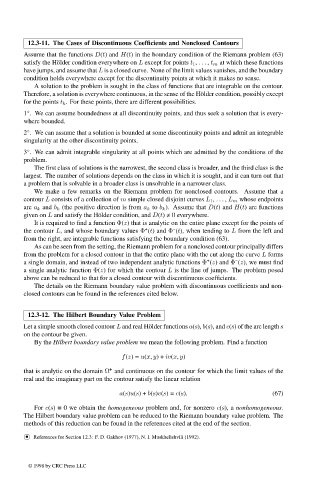Page 641 - Handbook Of Integral Equations
P. 641
12.3-11. The Cases of Discontinuous Coefficients and Nonclosed Contours
Assume that the functions D(t) and H(t) in the boundary condition of the Riemann problem (63)
satisfy the H¨ older condition everywhere on L except for points t 1 , ... , t m at which these functions
have jumps, and assume that L is a closed curve. None of the limit values vanishes, and the boundary
condition holds everywhere except for the discontinuity points at which it makes no sense.
A solution to the problem is sought in the class of functions that are integrable on the contour.
Therefore, a solution is everywhere continuous, in the sense of the H¨ older condition, possibly except
for the points t k . For these points, there are different possibilities.
◦
1 . We can assume boundedness at all discontinuity points, and thus seek a solution that is every-
where bounded.
2 . We can assume that a solution is bounded at some discontinuity points and admit an integrable
◦
singularity at the other discontinuity points.
◦
3 . We can admit integrable singularity at all points which are admitted by the conditions of the
problem.
The first class of solutions is the narrowest, the second class is broader, and the third class is the
largest. The number of solutions depends on the class in which it is sought, and it can turn out that
a problem that is solvable in a broader class is unsolvable in a narrower class.
We make a few remarks on the Riemann problem for nonclosed contours. Assume that a
contour L consists of a collection of m simple closed disjoint curves L 1 , ... , L m whose endpoints
are a k and b k (the positive direction is from a k to b k ). Assume that D(t) and H(t) are functions
given on L and satisfy the H¨ older condition, and D(t) ≠ 0 everywhere.
It is required to find a function Φ(z) that is analytic on the entire plane except for the points of
+
–
the contour L, and whose boundary values Φ (t) and Φ (t), when tending to L from the left and
from the right, are integrable functions satisfying the boundary condition (63).
As can be seen from the setting, the Riemann problem for a nonclosed contour principally differs
from the problem for a closed contour in that the entire plane with the cut along the curve L forms
+
–
a single domain, and instead of two independent analytic functions Φ (z) and Φ (z), we must find
a single analytic function Φ(z) for which the contour L is the line of jumps. The problem posed
above can be reduced to that for a closed contour with discontinuous coefficients.
The details on the Riemann boundary value problem with discontinuous coefficients and non-
closed contours can be found in the references cited below.
12.3-12. The Hilbert Boundary Value Problem
Let a simple smooth closed contour L and real H¨ older functions a(s), b(s), and c(s) of the arc length s
on the contour be given.
By the Hilbert boundary value problem we mean the following problem. Find a function
f(z)= u(x, y)+ iv(x, y)
+
that is analytic on the domain Ω and continuous on the contour for which the limit values of the
real and the imaginary part on the contour satisfy the linear relation
a(s)u(s)+ b(s)v(s)= c(s). (67)
For c(s) ≡ 0 we obtain the homogeneous problem and, for nonzero c(s), a nonhomogeneous.
The Hilbert boundary value problem can be reduced to the Riemann boundary value problem. The
methods of this reduction can be found in the references cited at the end of the section.
•
References for Section 12.3: F. D. Gakhov (1977), N. I. Muskhelishvili (1992).
© 1998 by CRC Press LLC
© 1998 by CRC Press LLC
Page 624

